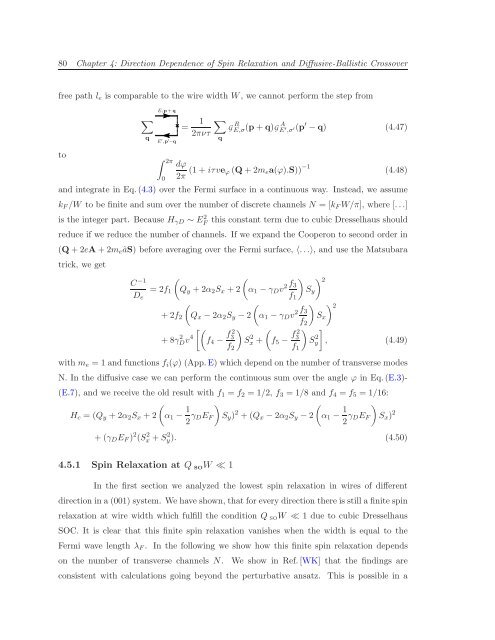Itinerant Spin Dynamics in Structures of ... - Jacobs University
Itinerant Spin Dynamics in Structures of ... - Jacobs University
Itinerant Spin Dynamics in Structures of ... - Jacobs University
Create successful ePaper yourself
Turn your PDF publications into a flip-book with our unique Google optimized e-Paper software.
80 Chapter 4: Direction Dependence <strong>of</strong> <strong>Sp<strong>in</strong></strong> Relaxation and Diffusive-Ballistic Crossover<br />
free path l e is comparable to the wire width W, we cannot perform the step from<br />
to<br />
∑<br />
q<br />
E,p + q<br />
E ′ ,p ′ −q<br />
∫ 2π<br />
0<br />
= 1<br />
2πντ<br />
∑<br />
GE,σ R (p+q)G E A ′ ,σ ′(p′ −q) (4.47)<br />
q<br />
dϕ<br />
2π (1+iτve ϕ(Q+2m e a(ϕ).S)) −1 (4.48)<br />
and <strong>in</strong>tegrate <strong>in</strong> Eq.(4.3) over the Fermi surface <strong>in</strong> a cont<strong>in</strong>uous way. Instead, we assume<br />
k F /W to be f<strong>in</strong>ite and sum over the number <strong>of</strong> discrete channels N = [k F W/π], where [...]<br />
is the <strong>in</strong>teger part. Because H γD ∼ E 2 F<br />
this constant term due to cubic Dresselhaus should<br />
reduce if we reduce the number <strong>of</strong> channels. If we expand the Cooperon to second order <strong>in</strong><br />
(Q+2eA+2m e âS) before averag<strong>in</strong>g over the Fermi surface, 〈...〉, and use the Matsubara<br />
trick, we get<br />
C −1 ( ( ) )<br />
= 2f 1 Q y +2α 2 S x +2 α 1 −γ D v 2f 2<br />
3<br />
S y<br />
D e f 1<br />
( )<br />
+2f 2<br />
(Q x −2α 2 S y −2 α 1 −γ D v 2f 2<br />
3<br />
S x<br />
)<br />
f 2<br />
[( ) ( )<br />
+8γDv 2 4 f 4 − f2 3<br />
Sx 2 + f 5 − f2 3<br />
Sy<br />
2 f 2 f 1<br />
]<br />
, (4.49)<br />
with m e = 1 and functions f i (ϕ) (App.E) which depend on the number <strong>of</strong> transverse modes<br />
N. In the diffusive case we can perform the cont<strong>in</strong>uous sum over the angle ϕ <strong>in</strong> Eq.(E.3)-<br />
(E.7), and we receive the old result with f 1 = f 2 = 1/2, f 3 = 1/8 and f 4 = f 5 = 1/16:<br />
H c = (Q y +2α 2 S x +2<br />
(α 1 − 1 )<br />
2 γ DE F S y ) 2 +(Q x −2α 2 S y −2<br />
(α 1 − 1 )<br />
2 γ DE F S x ) 2<br />
+(γ D E F ) 2 (S 2 x +S 2 y). (4.50)<br />
4.5.1 <strong>Sp<strong>in</strong></strong> Relaxation at Q SO W ≪ 1<br />
In the first section we analyzed the lowest sp<strong>in</strong> relaxation <strong>in</strong> wires <strong>of</strong> different<br />
direction <strong>in</strong>a(001) system. We have shown, that forevery direction thereis still af<strong>in</strong>itesp<strong>in</strong><br />
relaxation at wire width which fulfill the condition Q SO W ≪ 1 due to cubic Dresselhaus<br />
SOC. It is clear that this f<strong>in</strong>ite sp<strong>in</strong> relaxation vanishes when the width is equal to the<br />
Fermi wave length λ F . In the follow<strong>in</strong>g we show how this f<strong>in</strong>ite sp<strong>in</strong> relaxation depends<br />
on the number <strong>of</strong> transverse channels N. We show <strong>in</strong> Ref.[WK] that the f<strong>in</strong>d<strong>in</strong>gs are<br />
consistent with calculations go<strong>in</strong>g beyond the perturbative ansatz. This is possible <strong>in</strong> a
















